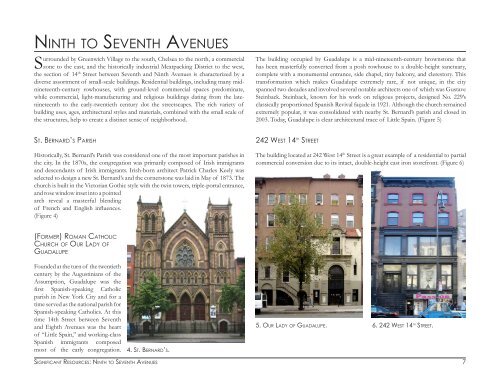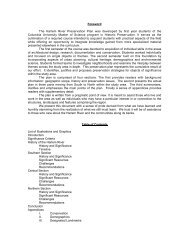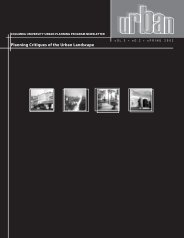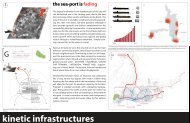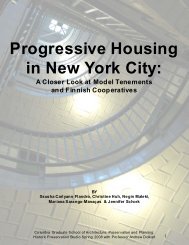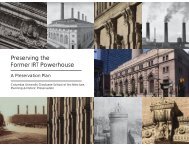14th street and union square preservation plan - Columbia ...
14th street and union square preservation plan - Columbia ...
14th street and union square preservation plan - Columbia ...
You also want an ePaper? Increase the reach of your titles
YUMPU automatically turns print PDFs into web optimized ePapers that Google loves.
NINTH TO SEVENTH AVENUES<br />
Surrounded by Greenwich Village to the south, Chelsea to the north, a commercial<br />
zone to the east, <strong>and</strong> the historically industrial Meatpacking District to the west,<br />
the section of 14 th Street between Seventh <strong>and</strong> Ninth Avenues is characterized by a<br />
diverse assortment of small-scale buildings. Residential buildings, including many midnineteenth-century<br />
rowhouses, with ground-level commercial spaces predominate,<br />
while commercial, light-manufacturing <strong>and</strong> religious buildings dating from the latenineteenth<br />
to the early-twentieth century dot the <strong>street</strong>scapes. The rich variety of<br />
building uses, ages, architectural styles <strong>and</strong> materials, combined with the small scale of<br />
the structures, help to create a distinct sense of neighborhood.<br />
The building occupied by Guadalupe is a mid-nineteenth-century brownstone that<br />
has been masterfully converted from a posh rowhouse to a double-height sanctuary,<br />
complete with a monumental entrance, side chapel, tiny balcony, <strong>and</strong> clerestory. This<br />
transformation which makes Guadalupe extremely rare, if not unique, in the city<br />
spanned two decades <strong>and</strong> involved several notable architects one of which was Gustave<br />
Steinback. Steinback, known for his work on religious projects, designed No. 229’s<br />
classically proportioned Spanish Revival façade in 1921. Although the church remained<br />
extremely popular, it was consolidated with nearby St. Bernard’s parish <strong>and</strong> closed in<br />
2003. Today, Guadalupe is clear architectural trace of Little Spain. (Figure 5)<br />
ST. BERNARD’S PARISH<br />
Historically, St. Bernard’s Parish was considered one of the most important parishes in<br />
the city. In the 1870s, the congregation was primarily composed of Irish immigrants<br />
<strong>and</strong> descendants of Irish immigrants. Irish-born architect Patrick Charles Keely was<br />
selected to design a new St. Bernard’s <strong>and</strong> the cornerstone was laid in May of 1873. The<br />
church is built in the Victorian Gothic style with the twin towers, triple-portal entrance,<br />
<strong>and</strong> rose window inset into a pointed<br />
arch reveal a masterful blending<br />
of French <strong>and</strong> English influences.<br />
(Figure 4)<br />
242 WEST 14 TH STREET<br />
The building located at 242 West 14 th Street is a great example of a residential to partial<br />
commercial conversion due to its intact, double-height cast iron storefront. (Figure 6)<br />
(FORMER) ROMAN CATHOLIC<br />
CHURCH OF OUR LADY OF<br />
GUADALUPE<br />
Founded at the turn of the twentieth<br />
century by the Augustinians of the<br />
Assumption, Guadalupe was the<br />
first Spanish-speaking Catholic<br />
parish in New York City <strong>and</strong> for a<br />
time served as the national parish for<br />
Spanish-speaking Catholics. At this<br />
time <strong>14th</strong> Street between Seventh<br />
<strong>and</strong> Eighth Avenues was the heart<br />
of “Little Spain,” <strong>and</strong> working-class<br />
Spanish immigrants composed<br />
most of the early congregation.<br />
4. ST. BERNARD’S.<br />
SIGNIFICANT RESOURCES: NINTH TO SEVENTH AVENUES<br />
5. OUR LADY OF GUADALUPE. 6. 242 WEST 14 TH STREET.<br />
7


